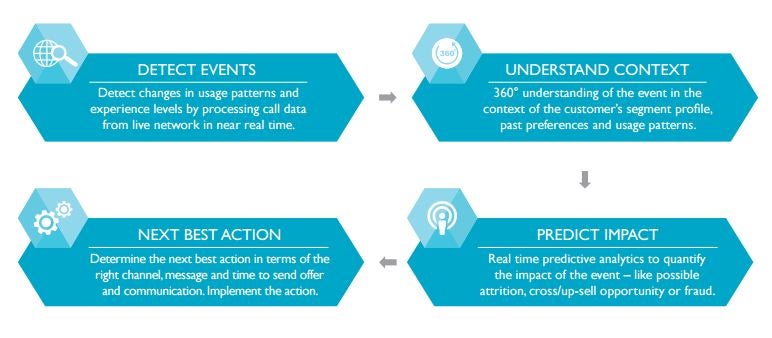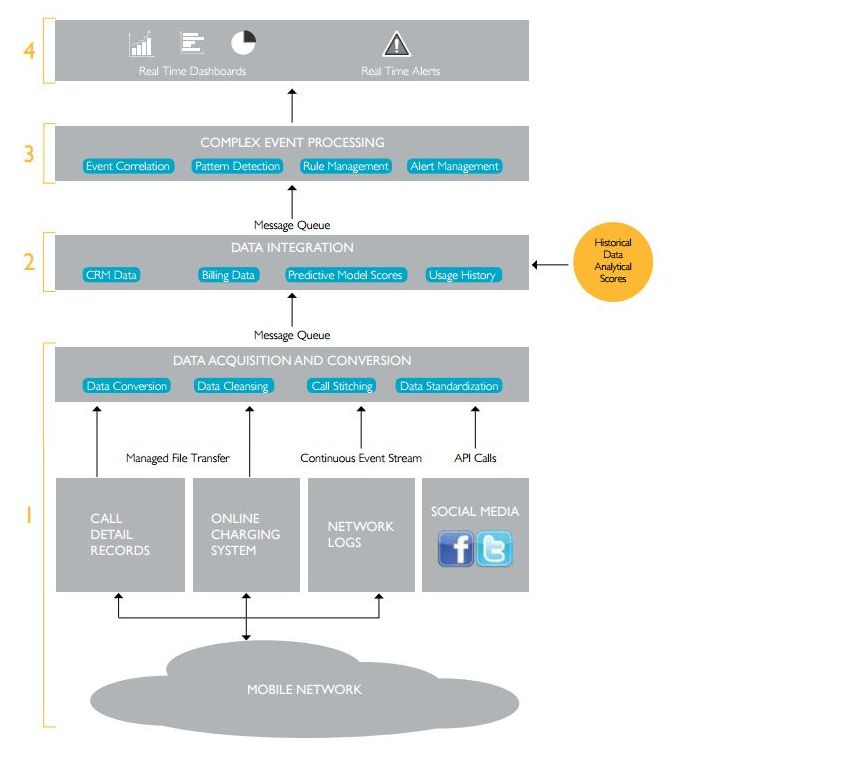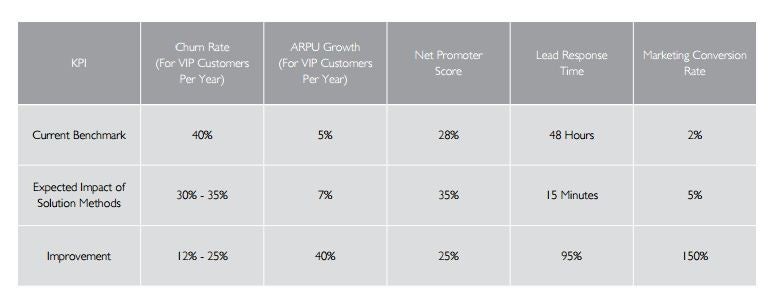Telecom service providers around the world are facing challenging market conditions and revenue declines. High subscriber churn rates – caused by network congestion and increasing competition from Over-The-Top (OTT) services – are the main culprits. As they continue to compete for new customers, their key revenue challenge is to arrest losses by retaining their existing customers and enhancing the income stream from each of these customers. This paper describes the current industry landscape and presents solutions to prevent churn and enhance revenue
Currently, telecom providers often don’t find out about negative experiences that can cause customers to switch providers or the usage patterns that point to a service upgrade opportunity until it’s too late. That’s because a negative experience isn’t known unless the customer reaches out to the call center to report it. To add to that, often there is an additional lag in time before the customer receives an appropriate response, such as an apology or discount. This lag also occurs between the time a new voice or data usage pattern is detected and the time the customer receives an optimized offer for a service upgrade. In current scenario, a timely response from the network to subscriber events are not intelligent or subscriber aware while intelligent and subscriber aware responses are not timely. The lack of timely insight and delayed response time translate into lost revenue
The solution is a telecom data analytics system that can detect churn risk and revenue enhancement opportunities from live subscriber call behavior and initiate dynamic real time responses. Through the use of near real-time integration and analysis of multiple data sources and predictive statistical models, telecom providers can expect to see a 12% to 25% reduction in churn and up to 40% increase in the average revenue per VIP user. [1]
Industry Landscape
Global telecom service providers are under intense pressure. On one hand, competition and regulations have made it extremely easy for customers to switch networks. On the other hand, OTT players like Skype and Netflix are able to monetize telecom traffic much more efficiently. The result is a trend toward consistently declining revenues and a bleak outlook for growth.
Customer attrition has been a key concern for Communication Service Providers. Service providers lose customer acquisition cost as well as the revenue for a year or more when a customer leaves the network. Market studies mentioned below confirm the severity of the situation.
- Churn costs AT&T, Verizon, Comcast and Time Warner Cable billions of dollars every year [2].
- Roughly 75% of the subscribers signing up every year come from another network—they are already churners [3].
- The churn rate in developing markets ranges from 20% to 70%. In some of these markets more than 90% of all mobile subscribers are on prepaid service. Some operators in developing markets lose in aggregate their entire subscriber base to churn in a year. [4][5]
The low barriers to switching make customers highly sensitive to any negative experience. Regulations like Mobile Number Portability further encourage network switching. Network quality is also an important factor - 45% of smartphone user churn happens due to network quality issues [6]. Clearly, preventing customer churn is a top business priority for service providers. In a recent survey, the world’s top 80 Telcos ranked improving customer experience and satisfaction as their number one business priority and number one IT investment goal [7].
New technology and new players are also exerting downward pressure on revenue. Global voice revenues are expected to drop at a CAGR of 2.4% and lose $170 billion in value between 2012 and 2020[8]. Estimates indicate that OTT VoIP alone will contribute to a loss of $479 billion in voice revenue for between 2012 and 2020. [8]
The massive growth of data services and transmission volume has not resulted in an equivalent revenue growth for network service providers. In fact, growth in data traffic and data revenue are expected to be mostly de-coupled[9].Data traffic is expected to grow at a CAGR of 108% between 2009 and 2014, but data revenue is expected to grow less than 30% in the same period. By 2014, more than 66% of data traffic is expected to be streaming media. So while network service providers are critical to supporting this massive growth in data traffic, most of the revenue will go to the content and OTT players.
To remain viable, telecom service providers need to hold on to the customers they have and find better ways to increase their share of each customer’s wallet - they need to improve their ability to detect and convert revenue enhancement opportunities.
Churn Prevention and Revenue Enhancement – The Current State of the Art
There are two main limitations that are negatively impacting telecom revenue:
- Lack of timely insights
- Delayed response time
Currently, subscribers who are at the risk of switching or who might be willing to buy additional services are identified based on past data about preferences, segments, usage patterns and call center interactions. Disruptive events, such as negative network experiences or changes in usage patterns, have a significant influence on subscriber behavior regarding churn or revenue enhancement
There is currently no way to proactively respond to the large number of subscribers who change their provider or service packages without calling the call center. As a consequence, operators are too reactive. They have had very limited success in keeping pace with rapidly changing customer preferences and usage patterns. Usually, by the time they do react the opportunity is lost.
The Key Performance Indicators (KPIs) for churn prevention and revenue enhancement processes are shown below. These metrics, which vary significantly from one market to another, are based on some engagements with Wipro’s very large telecom service provider customers. Improving performance on these KPIs is of paramount importance to service providers.





